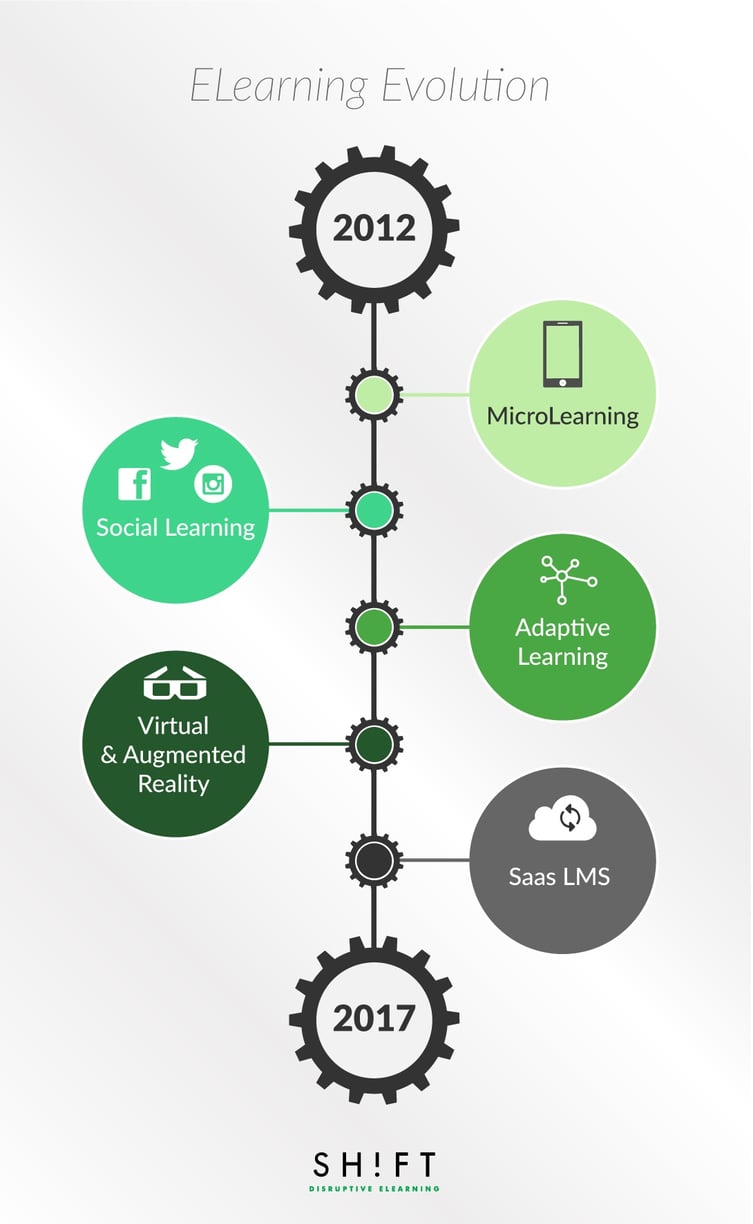Anyone who has been even remotely associated with eLearning over the past decade or so, will definitely have noticed the pace of change the industry has undergone – specifically over the last 5 years or so. From strides made in instructional design methodologies, such as Agile; to richer content integration in eLearning modules, such as video-on-demand and virtual reality, the industry has evolved at a tremendous pace.
Let’s take a look at three of the biggest changes in eLearning, and understand how we can successfully adapt to provide eLearners a richer learning experience.
Trends that Stand Out
While there are a number of eLearning “trends” that have bloomed and faded over the past 5 to 10 years or so, there are some that have clearly taken root. Not all of them have fully matured to their full potential, but the following three trends have come a long way in the past five years:

1) eLearning re-defined
If there is one trend that has emerged clear and distinct in the eLearning world, it’s the way that learners are engaged in training today. The definition of what “training” means has changed. Over the last half decade or so, breakthrough research in human psychology and technology have spawned a number of newer innovations on how people learn, including:
- Microlearning: This is a trend that has seen learners consume content in short bursts, on-demand and through bite-sized content. Rather than sit through hours-long online courses, the mobile revolution has made more learners turn to microlearning as their learning approach of choice.
- Social Learning: The advent of downsizing, outsourcing, and de-centralization as a way to drive corporate efficiencies, has seen trainers turn to social learning as a means to train a geographically diverse workforce over the last half decade or so. One of the key drivers of this newer approach to learning is also the maturity of social media platforms like Twitter, Facebook, YouTube, and Instagram.
- Adaptive Learning: Technological innovations over the past five years or so have also helped eLearning move away from Instructor Lead Training (ILT), and to adapt to a uniquely learner-driven model. Adaptive learning helps modify training content and experiences based on each student’s responses and interactions with the training tools they use.
So how have these paradigm shifts made an impression on eLearning? Where five years or more ago, trainers used to be the center of most training initiatives, these changing trends in eLearning today put the student at the heart of all training initiatives.
2) Virtual Reality (VR) and Augmented Reality (AR)
Over the last 5 years, there have been breakthrough developments in the application of VR and AR in training. Thanks to faster processors, smaller-footprint microchips, and technological innovations such as Apple’s AR glasses, Facebook’s Oculus and Google Glass, eLearning applications that were previously unthinkable, for instance training doctors in complex medical procedures, are now almost commonplace. Today, an AR/VR experience:
- Train students through eLearning on subjects that traditionally used to solely be the domain of ILT
- Turns the classroom or conference room into any imaginable environment – a factory floor, high-rise building construction site, or high-tech laboratory, with none of the associated health and safety concerns – perfect for trial and error learning!
- Limits eLearning only to the extent that the instructional designer can dare to think of or visualize
By incorporating virtual environments and situations into eLearning curriculum, instructional designers are delivering real life learning experiences to students who otherwise would never have such opportunities available to them. VR/AR are empowering eLearning content developers to make learning more engaging for students.
Read more:
- The AI Revolution: Why You Need to Learn About Deep Learning
- 5 Reasons to Join the Virtual Reality Learning Revolution Right Now
3) Trends in Learning Management Systems’ (LMS)
Since the first cloud-based LMS was launched in 2008, there have been ongoing efforts to change how training content in the cloud is managed and delivered. Around 5 years ago (2012), an initial effort was made to leverage cloud technologies to deliver LMS as a SaaS (Software-as-a-Service) offering. With SaaS solutions:
- Companies find it cost-effective to “rent” LMS solutions as opposed to buying them outright as before
- Instructional designers find it more convenient to develop and manage their eLearning content online, as opposed to using purely desktop tools as they did a half-decade or more ago
- Learners find it more convenient to access and consume content in the cloud 24/7, using mobile devices such as smartphones and tablets
- More learning management systems are now serving as career-planning tools. Learn more here.
Today, there are more mainstream LMS developers who have switched to SaaS offerings than ever, including some of the industry’s heavyweights that previously dominated the traditional LMS scene.
Whitepaper: How to Select LMS
The Future of eLearning – It’s Here!
Those of us who are waiting for the future of eLearning to make itself visible, so we can fully embrace it, are already missing out on something big: The future is already here…we need to adapt our eLearning approaches to embrace that future NOW, or we’ll soon be left way behind!
- Explore the use of VR in the classroom, whether it’s a virtual class or a blended one. Take a look at your ongoing projects, and see if you can provide your learners a better experience through virtual and augmented reality.
- Leverage any number of social networking tools and approaches out there, including Podcasts, Blogs, Videos and RSS feeds, to not only deliver your content but to also stay connected with your community of eLearners
- If you are hesitant to embrace the cloud for your eLearning content creation and management, then evaluate some free tools available to you.
These three trends in eLearning have revolutionized the way training is viewed (as a concept), developed (in terms of content) and delivered (in terms of learner’s experience). If you haven’t taken the first steps to exploring some or all of them, then start down that path NOW…because that’s exactly what all of your clients, competitors and students will be embracing in the years to come.
Interesting reads:
- The Future of Corporate Training in a Changing World by Caroline Brant
- Learners are learning differently; are you changing the way you train and support them?
- Which Technologies are Changing the Way People Learn?



